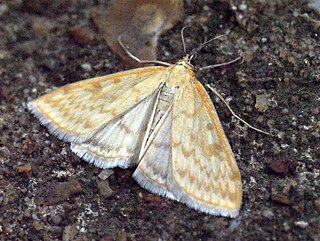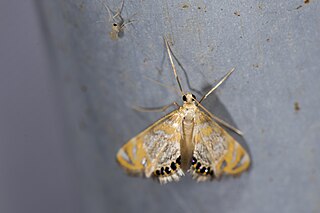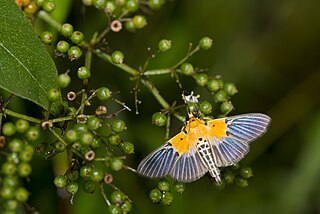
The Pyralidae, commonly called pyralid moths, snout moths or grass moths, are a family of Lepidoptera in the ditrysian superfamily Pyraloidea. In many classifications, the grass moths (Crambidae) are included in the Pyralidae as a subfamily, making the combined group one of the largest families in the Lepidoptera. The latest review by Eugene G. Munroe and Maria Alma Solis retain the Crambidae as a full family of Pyraloidea.

The Pyraloidea are a moth superfamily containing about 16,000 described species worldwide, and probably at least as many more remain to be described. They are generally fairly small moths, and as such, they have been traditionally associated with the paraphyletic Microlepidoptera.

Udea ferrugalis, the rusty dot pearl, is a moth of the family Crambidae. The species was first described by Jacob Hübner in 1796.

Sitochroa verticalis, common name lesser pearl, is a species of moth of the family Crambidae.

Nymphicula is a genus of moths of the family Crambidae.

Sclerocona is a genus of moths of the family Crambidae which contains only one species, Sclerocona acutella. It was first described by the Prussian biologist Eduard Friedrich Eversmann in 1842.

Parapoynx fluctuosalis or Fluctuating China-mark or Waved China-mark, is a moth of the family Crambidae. It is a widespread species, known from Africa, India, Sri Lanka, China, Japan, Malaysia, Taiwan, Guam, Hawaii, Fiji, Australia and the Galápagos Islands. It is also an introduced species in Europe, where it has been recorded from Great Britain, the Iberian Peninsula and Sardinia.

Hypsopygia mauritialis is a moth of the family Pyralidae described by Jean Baptiste Boisduval in 1833. It is a widespread species, known from Africa, India, China, Malaysia, Taiwan, Japan, Australia and Hawaii.

Pyralis regalis is a species of snout moth. It is found from most of Europe east to Asia, including China, Cambodia, Myanmar, India, Russia, Korea, Japan and Taiwan.

Glyphodes negatalis, the karanj defoliator, is a moth of the family Crambidae. The species was first described by Francis Walker in 1859. It has a wide range in the tropics, including South Africa, The Gambia, Mali, India, Sri Lanka, Hong Kong, Japan, and eastern Australia.
Stericta kiiensis is a species of snout moth. It is found in Japan.
Pseudacrobasis is a genus of snout moths.
Anania luctualis is a species of moth in the family Crambidae. It is found in France, Switzerland, Austria, Italy, Croatia, Bosnia and Herzegovina, Hungary, Slovakia, Romania, Poland, Belarus and Russia. In the east, the range extends to China and Japan.

Herpetogramma basalis is a species of moth in the family Crambidae. It is found on the Canary Islands and in Japan, China, Australia, Sri Lanka, India, Indonesia, La Réunion, South Africa, and Mali.
Orthaga onerata is a species of snout moth in the genus Orthaga. It is found in Japan.
Nymphula distinctalis is a moth in the family Crambidae. It was described by Ragonot in 1894. It is found in the Russian Far East and Japan.
Parapoynx ussuriensis is a moth in the family Crambidae. It was described by Rebel in 1910. It is found in Russia and Japan.

Nevrina procopia is a moth in the family Crambidae. It was described by Stoll in 1781. The type locality is unknown. It is found from Sri Lanka, India, Bhutan, South China, Taiwan, southern Japan, Philippines, Malaysia, Singapore, Sumatra, Java, and New Guinea.
Patissa fulvosparsa is a moth in the family Crambidae. It was described by Arthur Gardiner Butler in 1881. It is found in China, Taiwan, Japan, Korea, India and Indonesia.











